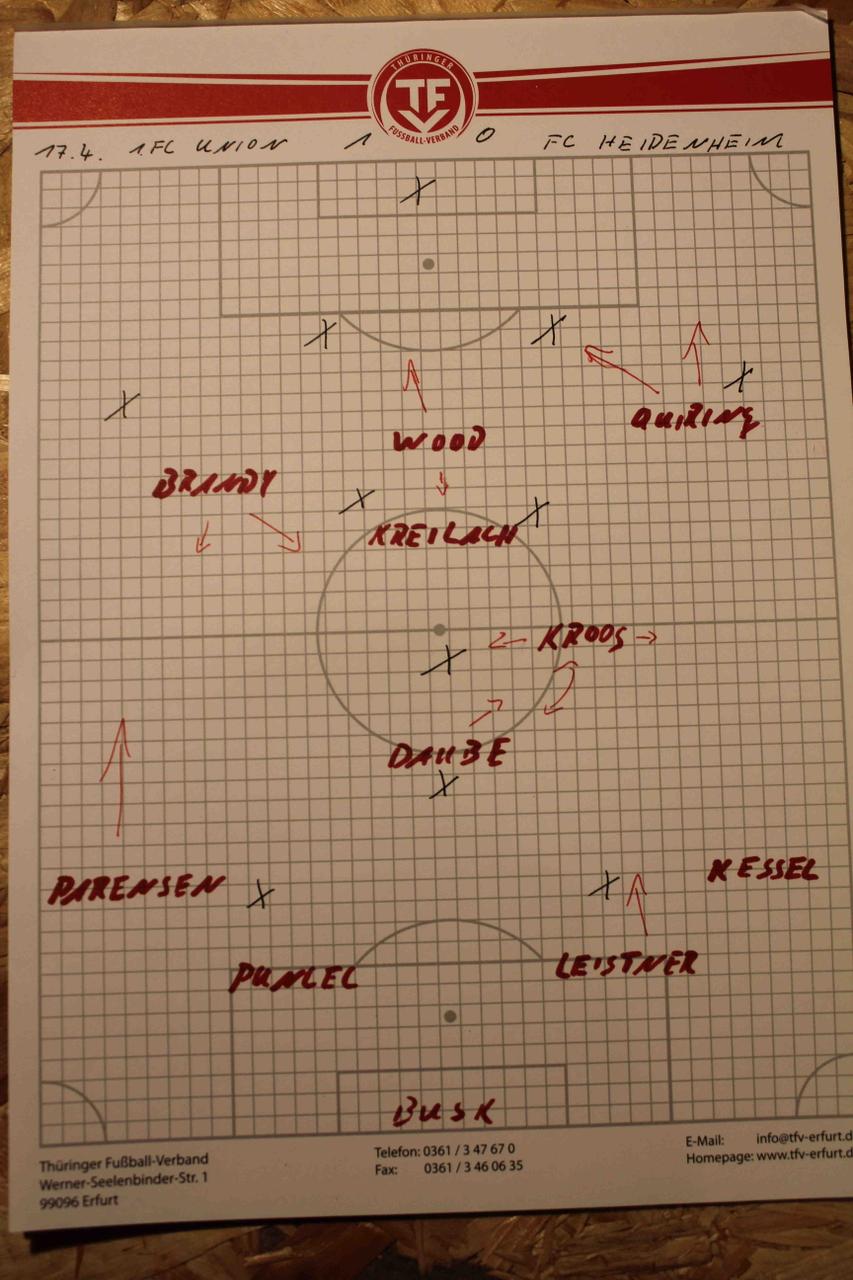Control
In advance of Sunday's game, Union head coach André Hofschneider demanded that his team seize control of what happens on the pitch at Stadion an der Alten Försterei. They happened to fail at that, but nevertheless beat Southwestern Germany's Heidenheim by one goal to nil.
Shapes
The dominating theme to this match was the approach chosen by the away side. They lined up in a 1433 formation - as did their hosts -, but managed to gain an advantage that allowed them to get a grip on the game. This they used to turn it into a feisty and at time drawn out affair.

Equal in numbers, yet outnumbered
The structure of play here was dictated Heidenheim's Pressing, which consisted in their wingers covering Union's centre halfs, and the central striker Leipertz playing on whoever occupied the pivot role for Union. In this way, they rather effectively prevented the Köpenick side from playing out of their own half in controlled fashion.
Individual issues on the day contributed to Union being unable to shake off that press. Keeper Jakub Busk didn't quite manage to emulate his role model Edwin van der Sar in building from the back and repeatedly struggled in both pass selection and execution. The same was true for the Red-and-White's full backs, particularly Michael Parensen. [That both players distinguished themselves in classical defensive play isn't in any doubt.] Yet, especially about Parensen and Kessel it must be said that they were tasked with an unthankful job, as they were playing out of the least promising area on the field in attacking terms and faced with a midfield shielded off them by their opponents and no other passing destinations in close proximity. Simultaneously, they were the Union players who were afforded the most time on the ball and put under the least pressure. As such, they were the natural passing option for their pressed colleagues. The result: lots of posession, few good opportunities.
Consequently, Union were in no position to productively use the free spaces available to them, which were not terribly attractive ones in any case. In midfield, on the other hand, they found themselves outnumbered - counterintuitively so, given that both teams played in the same formation. Yet, Heidenheim had taken care of one of their opponents central trio expending a striker to the role, and so had a spare man in the central area of play. Such 2v3 overloads allowed the guests to win the ball in those central zones and use it to play quick chipped passes in behind the Berlin back four. They were, however, unable to turn those opportunities into clear-cut chances, owing to the dexterity and chuzpe of Toni Leistner et al.
Of course, this constellation also presented Union with problems in their attacking efforts. The most promising of those came about when either the central midfielders, Daube and Felix Kroos, found good solutions under pressure and managed to execute them as well; or when the wingers (Brandy) moved inside to equal out the deficit there; or if positional play could be circumvented alltogether (in counterattacks and - yet again primarily - from set pieces).
Bobby, Bobby Wood
The performances of Wood in these last few months have been sensational. Scoring 12 in ten games and 10 (ten) goals in his last eight matches, in which he never went without at least one, he is on a better streak than Antoine Griezmann and, thereby, a candidate for the Ballon d'Or. Only Heidenheim seemingly didn't notice any of that, judging by the space afforded to him for the decisive goal.
Nonetheless, Wood was involved in many deficient pieces of play this after noon. In some cases, shortcomings were due to the fact that he is not a perfect player [no shit]; but in others, the cause for things not quite coming off was that Wood was springing into action too far from real danger zones and too isolated from his team mates. Given an attacking structure that allows him to get involved higher up the pitch and being accompanied by a strike partner able to keep up with him (Skrzybski), Wood could integrated even better and more effectively. Frightening stuff.
In this particular game, in contrast, he sometimes dropped deeper - behind the wingers - and thus recreated the diamond shape visible in Unions last outing. This was made possible by Quiring's industry in getting himself involved in the Press - but it didn't contribute to solving the issues outlined here.
Play of the match
The way in which the series of corner kicks leading up to the goals developed. In early build up play, Kreilach dropped into deep midfield spaces, in an apparent attempt to disrupt Heidenheim's front footi defense. This attempt was frustrated as the opponent handed off the Union midfielders accurately to one another, forcing Jakob Busk to play the ball long, finding only a Heidenheim player's head. Only because from there the ball found its way to Kreilach, the Croat had a chance to play a nice first time through ball to Brandy, which forced his defender to concede a corner kick, consequently a goal and ultimately the game.